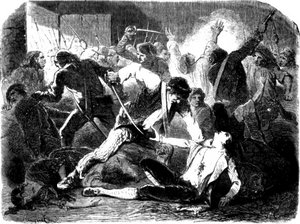 The Benedictines and Carmelites in some places in the USA, and of course in England and France, liturgically remember the September Martyrs, also called the Paris Martyrs; you will also see the memorial listed as "Blessed John du Lau and companions" after the Archbishop of Arles, the highest ranking prelate among the 191 martyrs. The Benedictine nuns of Stanbrook Abbey are connected with the Carmelite nuns and retain some of the relics. Historians tells us that about 1500 clergy and religious were killed in 1792. And this act of martyrdom inspired the writing of Georeges Bernanos's "Dialogues of the Carmelites" and the famous opera of Francis Poulenc, by the same name.
The Benedictines and Carmelites in some places in the USA, and of course in England and France, liturgically remember the September Martyrs, also called the Paris Martyrs; you will also see the memorial listed as "Blessed John du Lau and companions" after the Archbishop of Arles, the highest ranking prelate among the 191 martyrs. The Benedictine nuns of Stanbrook Abbey are connected with the Carmelite nuns and retain some of the relics. Historians tells us that about 1500 clergy and religious were killed in 1792. And this act of martyrdom inspired the writing of Georeges Bernanos's "Dialogues of the Carmelites" and the famous opera of Francis Poulenc, by the same name.The French "virtue" of liberty was not applied to the Church. In fact, quite the opposite. Just a few years after the French Revolution there was a purge of high and low clergy, religious and laity. The killing of the clerics happened because the republican government seized control of the Church, a matter that was (and, remains so today) unacceptable to Catholic ecclesiology. As the state has its duty and responsibility for civic order and leadership, the Church's mandate is found in sacred Scripture, Tradition and the Magisterium and not in positive law; in short all things pertaining to the salvation of souls. Matters of state are not the same for the Church and vice versa unless these matters concern the moral law. This, however, was not the reigning ideology. The Republicans passed legislation that rejected the authority of the Church and it wanted the bishops and priests to uphold the new laws giving the state control over the Church. Something similar had with the Oath of Supremacy in England. Clergyman and religious weren't the only one to offer their lives as a gift to the Lord. the laity lost their lives too, aristocrats and peasant alike. Refusing to take the oath got you the label: "non-jurors."
Some of the 191 were killed in cold blood, others were asked a question and depending on how they answered determined if they lived or died. No mental reservation was kept when it came to following the wisdom of the Church or the wisdom of man.
One observer noted that common among those put to death was that all faced death in a happy manner as one who would've gone to a wedding. Indeed, the wedding feast the martyrs were going to was the Wedding Feast of the Lamb (see the Book of Revelation).
The names beatified by Pope Pius XI in 1926 are listed here.


Leave a comment